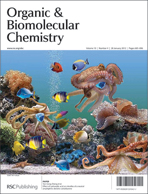H-bond complexes between 3- or 4-OH phenoxyl radicals and various H-bond accepting molecules were investigated by experimental and computational methods. The H-bond donating ability (α2H) of 2,6-di-tert-butyl-4-hydroxyphenoxyl radical (1) was determined as 0.79 ± 0.05 by measuring, using EPR spectroscopy, the variations of the hyperfine splitting constants of 1 as a function of the acceptor concentrations. A computational approach, based on DFT calculations, was employed to estimate the α2H values for OH-substituted phenoxyl radicals that were not persistent enough to be studied by EPR spectroscopy. The α2H value calculated for the 2,6-di-methyl analogue of 1 was 0.76, in good agreement with EPR experiments. The α2H values for 2-methoxy-4-hydroxy (3), 4-hydroxy (4), 4,6-di-methyl-3-hydroxy (5) and 3-hydroxy (6) phenoxyl radicals were computed as 0.77, 0.84, 0.66 and 0.71, respectively, indicating that α2H values were dependent on the presence of electron donating substituents and on the relative positions of the –OH and –O˙ groups. By correlating the α2H values for 4 and 6 with their water and gas-phase acidities, an unexpected role of water in promoting proton dissociation from these radicals was evidenced.

You have access to this article
 Please wait while we load your content...
Something went wrong. Try again?
Please wait while we load your content...
Something went wrong. Try again?


 Please wait while we load your content...
Please wait while we load your content...